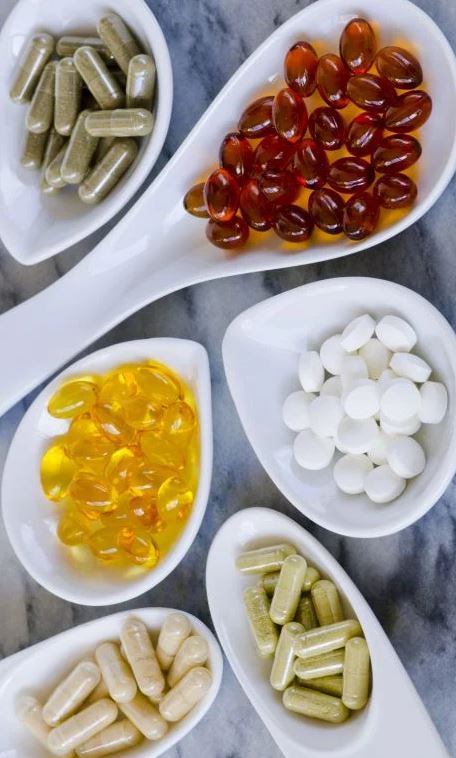Building a Supplement Program:
The Importance of a Foundation
Introduction
Dietary supplements include vitamins, minerals, other food factors, and herbal compounds. The very term dietary supplement indicates these compounds are supplementary measures for your health-promoting diet, lifestyle, and attitude. You cannot make up for poor dietary habits, a negative attitude, and a lack of exercise or sleep by taking pills – whether the pills are drugs or dietary supplements.
In the last few decades, more people than ever are taking nutritional supplements. The big reason is that they know they are not getting all they need from their diets and they realize that supplements make them feel healthier. In the United States, comprehensive studies sponsored by the US government (e.g., NHANES I, II, III, and 2007–8; Ten State Nutrition Survey; USDA nationwide food consumption studies) have revealed marginal nutrient deficiencies exist in about 50% of the US population. For some selected nutrients in certain age groups, more than 80% of the group consumes less than the recommended dietary intake (RDI) level.


These studies indicate that it is extremely unlikely that a “normal” diet will meet the recommended dietary intake for all nutrients. In other words, while it is theoretically possible that a healthy individual can get all the nutrition they need from foods, the fact is that most people do not even come close to meeting all their nutritional needs through diet alone. To increase their intake of essential nutrients, many people look to vitamin and mineral supplements.
When most people in developed countries are deficient in a vitamin or mineral, the level of deficiency is usually not to a point where obvious nutrient deficiencies are apparent. A severe deficiency disease like scurvy – caused by a severe lack of vitamin C – is extremely rare, but marginal vitamin C deficiency is thought to be relatively common. The term subclinical deficiency or “insufficiency” is often used to describe marginal nutrient deficiencies. A subclinical or insufficiency indicates a deficiency of a particular vitamin or mineral that is not severe enough to produce a classic deficiency sign or symptom.
In many instances, the only clue of a subclinical nutrient deficiency may be fatigue, lethargy, difficulty in concentration, a lack of well-being, or some other vague symptom. Worse, however, is that chronic, long-term marginal deficiencies are an underlying cause of most of the disease we suffer in Western societies. Diagnosis of subclinical deficiencies is an extremely difficult process that involves detailed dietary or laboratory analysis. It is not worth the cost of performing these tests because they are usually far more expensive than taking a year’s supply of the vitamin being tested for.



What Exactly Do Vitamins and Minerals Do?
The key functions of nutrients like vitamins and minerals in the human body revolve around their roles as essential components in enzymes and coenzymes. Enzymes are molecules involved in speeding up the chemical reactions necessary for human bodily function. Coenzymes are molecules that help the enzymes in their chemical reactions. Enzymes and coenzymes work to either make or break the chemical bonds that join molecules together. One of the key concepts in nutritional medicine is supplying the necessary support or nutrients to allow all the enzymes of a particular tissue to work at their optimum levels.
Most enzymes are composed of a protein along with a cofactor that is typically an essential mineral and/or vitamin. If an enzyme is lacking the essential mineral or vitamin, it cannot function properly. By providing the necessary mineral or vitamin through diet or a dietary supplement, the enzyme is then able to perform its vital function. For example, zinc is necessary for the enzyme that activates vitamin A in the visual process. Without zinc in the enzyme, vitamin A cannot be converted to the active form. This deficiency can result in what is known as night-blindness. By supplying the enzyme with zinc, we are performing enzymatic therapy and allowing the enzyme to perform its vital function.
Many enzymes require additional support to perform their function. The support is in the form of a coenzyme, a molecule that functions along with the enzyme. Most coenzymes are also composed of vitamins and/or minerals. Without the coenzyme, the enzyme is powerless. For example, vitamin C functions as a coenzyme to the enzyme proline hydroxylase, which is involved in collagen synthesis. Without vitamin C, collagen synthesis is impaired, resulting in failure of wounds to heal, bleeding gums, and easy bruising. There may be plenty of proline hydroxylase (the enzyme), but to function it needs vitamin C.


Building a Strong Foundation
There are four primary cornerstones in building a strong foundation for a dietary supplement program:
- Take a high-quality multiple vitamin and mineral formula.
- Take enough vitamin D3 (typically 2000–4000 IU daily) to elevate your blood levels to the optimal range.
- Take a high-quality fish oil product to provide 1000 mg of EPA+DHA daily.
- Take extra plant-based antioxidants like flavonoid-rich extracts.
My recommendation is that before you start looking for specific benefits from other dietary supplements, be sure you have this strong foundation. For instance, you may be familiar with the joint supporting nutrient glucosamine sulfate. It works in promoting joint health by stimulating the manufacture of the cartilage matrix. But that process also involves various essential vitamins and minerals. And you can help your body’s repair process by making sure there is plenty of protection in the form of omega-3 fatty acids and flavonoids, both of which have also shown to promote improved cartilage function. The point is that better results with glucosamine will occur if it is added onto these base recommendations rather than on its own.
4 base recommendations
1. Take a High-Quality Multiple Vitamin and Mineral Formula
Taking a high-quality multiple vitamin and mineral supplement providing all of the known vitamins and minerals is crucial to building a foundation. Dr. Roger Williams, one of the premier biochemists of the twentieth century, stated that healthy people should use multiple vitamin and mineral supplements as an “insurance formula” against possible deficiency. I agree. Tables 1 and 2 provide an optimum intake range to guide you in selecting a high-quality formula.
(Note: Vitamins and minerals are measured in different units: IU = International Units, mg = milligrams, mcg = micrograms.)
Table 1. Vitamin Optimum Intake Range for Adults
| Vitamin | Recommended Intake Range |
| Vitamin A (retinol)a | 2500–5000 IU |
| Vitamin A (from beta-carotene) | 5000–25,000 IU |
| Vitamin B1 (thiamin) | 5–100 mg |
| Vitamin B2 (riboflavin) | 5–50 mg |
| Vitamin B3 (niacin) | 10–100 mg |
| Vitamin B5 (pantothenic acid) | 25–100 mg |
| Vitamin B6 (pyridoxine) | 25–100 mg |
| Vitamin B12 (methyl cobalamin) | 100–400 mcg |
| Vitamin C (ascorbic acid)b | 250–1000 mg |
| Vitamin Dc | 400–2000 IU |
| Vitamin E (mixed tocopherols)d | 100–200 IU |
| Vitamin K1 or K2 | 60–300 mcg |
| Niacinamide | 10–30 mg |
| Biotin | 100–300 mcg |
| Folic acid | 400 mcg |
| Choline | 10–100 mg |
| Inositol | 10–100 mg |
Notes:
a Women of childbearing age who may become pregnant should not take more than 2500 IU of retinol daily due to the possible risk of birth defects.
b It may be easier to take vitamin C separately.
c Elderly people in nursing homes living in northern latitudes should supplement at the high range.
d It may be more cost-effective to take vitamin E separately rather than as a component of a multiple vitamin.
Table 2. Mineral Optimum Intake Range for Adults
| Mineral | Recommended Intake Range |
| Boron | 1–6 mg |
| Calciuma | 250–1000 mg |
| Chromiumb | 200–400 mcg |
| Copper | 1–2 mg |
| Iodine | 50–150 mcg |
| Ironc | 15–30 mg |
| Magnesium | 250–500 mg |
| Manganese | 3–5 mg |
| Molybdenum | 10–25 mcg |
| Potassium | N/Ad |
| Selenium | 100–200 mcg |
| Silica | 1–25 mg |
| Vanadium | 50–100 mcg |
| Zinc | 15–30 mg |
Notes:
- Women who have or who are at risk of osteoporosis may need to take a separate calcium supplement to achieve the recommended daily level of 1000 mg.
- For diabetes and weight loss, doses of 600 mcg of chromium can be used.
- Most men as well as most women who have gone through menopause rarely need supplemental iron.
- The US Food and Drug Administration (FDA) restricts the amount of potassium in supplements to no more than 99 mg. Potassium needs are best met through diet and the use of potassium salts used as salt substitutes.
Read labels carefully to find multiple vitamin/mineral formulas that contain doses in these ranges. Be aware that you will not find a formula that provides all of these nutrients at these levels in one single pill – it would simply be too big. You will usually need to take at least 2–6 tablets per day to meet these levels. While many one-a-day supplements provide good levels of vitamins, they tend to provide insufficient amounts of some of the minerals. As a result, you may need to take a separate mineral formula or individual minerals (e.g., calcium, magnesium, iron, etc.) to meet those requirements. Remember that your body needs the minerals as much as the vitamins because the two nutrients work hand-in-hand.
2. Take Additional Vitamin D3
A huge and growing amount of research has now shown that vitamin D deficiency is very common – at least 50% in the general population and 80% in infants – making it one of the most common medical conditions in the world. Vitamin D deficiency plays a major role in the development of many chronic degenerative diseases. Supplementation of vitamin D may be the most cost-effective strategy in improving health, reducing disease, and living longer.
Vitamin D is more of a prohormone than a vitamin. You produce vitamin D3 in your body through the reaction of a chemical in your skin in response to sunlight. Vitamin D3 is converted by the liver and then the kidneys to its active hormonal form, 1,25-dihydroxyvitamin D3, which acts as a vital key to unlocking binding sites on human genes (DNA) for the expression of the genetic code. Human DNA contains more than 2,700 binding sites for calcitriol. Those binding sites are near genes involved in virtually every known aspect of health in humans.
There are two primary forms of supplemental vitamin D: D3 (cholecalciferol) and D2 (ergocalciferol). Supplemental vitamin D3 is derived from lanolin, cod liver oil, or lichen sources and is the form of vitamin D that most effectively treats vitamin D deficiency. Vitamin D2 is derived from fungal sources, so it is referred to as vegetarian vitamin D. It is not naturally present in the human body and has actions within the body different from those of vitamin D3, so most experts prefer D3.
The ideal method for determining the optimal dosage requires a blood test for 25-hydroxyvitamin D3 (25(OH)D). While some people can achieve an optimal level with just 600 IU per day or 20 minutes of daily sunlight exposure, others have a genetic requirement for as much as 10,000 IU per day. The only way to determine where you fall is by testing. Many health care practitioners are now routinely checking vitamin D status in their patients. Tests are also available direct-to-consumers where you collect a small blood sample by skin prick and send it to the lab. For optimum health, 25(OH)D blood levels should be between 50–80 ng/mL (125–200 nmol/L).
Dosage: 2,000–5,000 IU of D3 daily.
3. Take a High-Quality Fish Oil Supplement
One of the major advances in nutritional medicine is the ability to produce a fish oil supplement that is a highly concentrated form of long-chain omega-3 fatty acids and also free from lipid peroxides, heavy metals, environmental contaminants, and other harmful compounds. These pharmaceutical-grade fish oil concentrates are so superior to earlier fish oil products that they have revolutionized nutritional medicine because of the health benefits they produce.
Why are the long-chain omega-3 fatty acids so important? The answer has to do with the function of these fatty substances in cellular membranes and inflammation. A diet that is deficient in omega-3 fatty acids, particularly eicosapentaenoic acid (EPA), docosahexaenoic acid (DHA), and docosapentaenoic acid (DPA), results in altered cell membranes. Without a healthy membrane, cells lose their ability to hold water, vital nutrients, and electrolytes. They also lose their ability to communicate with other cells and be controlled by regulating hormones. They simply do not function properly. Cell membrane dysfunction is a critical factor in the development of virtually every chronic disease.
EPA, DHA, and DPA are also transformed into regulatory compounds known as prostaglandins, resolvins, protectins, and endocannabinoids, which influence many body processes. Taking supplemental levels of these omega-3 fatty acids can be useful in re-establishing proper cellular function through these mediators.
When selecting a fish oil supplement, it is essential to choose a brand that you trust. Quality control is an absolute must to ensure the product is free of heavy metals like lead and mercury, pesticides, damaged fats (lipid peroxides), and other contaminants. Read the label carefully to ensure the product contains the omega-3 fatty acids rather than fish oil.
Dosage: 1000 mg of EPA+DHA+DPA daily. When there is an increased need, the dosage recommendation increases to 3000 mg daily.
4. Take Extra Plant-Based Antioxidants
Flavonoids are plant pigments that exert antioxidant activity. They are more potent and effective against a broader range of oxidants than the traditional antioxidant nutrients vitamins C and E, beta-carotene, selenium, and zinc. Besides lending color to fruits and flowers, flavonoids are responsible for many of the medicinal properties of foods, juices, herbs, and bee pollen. More than 8,000 flavonoid compounds have been characterized and classified according to their chemical structure.
One of the most beneficial groups of flavonoids is proanthocyanidins (also referred to as procyanidins or PACs). A great deal of clinical support shows supplementation with PACs such as grape seed or pine bark extract at dosages of 150–300 mg considerably improves the serum (blood) total antioxidant capacity as well as benefits in many health conditions including:
- Asthma
- Atherosclerosis, hypertension, metabolic syndrome, and type 2 diabetes
- Attention Deficit Disorder
- Male Infertility
- Osteoarthritis
- Periodontal disease
- Varicose veins, venous insufficiency and capillary fragility
- Visual function, retinopathy and macular degeneration
Click Here for Recommended Grape Seed Extract Products
An alternative to flavonoid-rich extracts is curcumin – the yellow pigment of turmeric (Curcuma longa) – the chief ingredient in curry. Curcumin is one of the most intensely studied natural products available today. As of 2020, more than 8,000 scientific studies have been conducted focusing on curcumin. While it has demonstrated significant activity in many experimental and clinical studies, its primary biological effects relate to its action as a broad-spectrum antioxidant and profound anti-inflammatory agent. These are the recommended levels for the two best researched forms of curcumin on the market:
- Theracurmin®: 60–180 mg daily
- Meriva®: 1000 mg providing 200 mg of curcumin daily
Click Here to View Recommended Curcumin Products on iHerb


